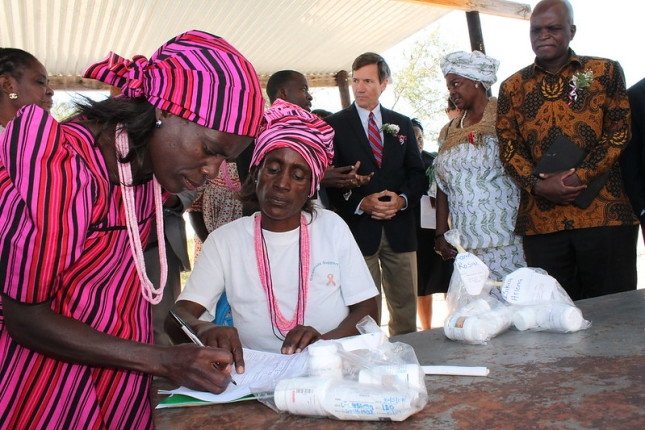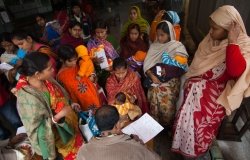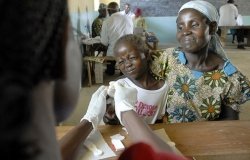
A blog of the Wilson Center
PEPFAR: Looking Back, Looking Ahead

Photo courtesy of USAID in Africa
By the end of 2024, only 10% of the US Representatives who voted to create PEPFAR will still be in office—and none of the legislation’s original co-authors will remain.
In 2008, Tanzania President Jakaya Kikwete implored, “Let me just make an appeal: Let PEPFAR continue...Can you imagine if this program is discontinued or disrupted? There would be so many people who lose hope, and certainly there will be death. You create more orphans… for PEPFAR not to continue, it's a recipe for disaster for us.”
Standing next to him at a joint public appearance, US President George W. Bush said, “It appalled me very early on in my administration to realize that an entire generation of people could be lost to HIV/AIDS, and that those of us who were comfortable weren’t doing much about it.”
In the two decades since the President’s Emergency Plan for AIDS Relief, or PEPFAR, was signed into law, the program has saved 25 million lives and provided life-saving antiretroviral treatment to millions more. Through its prevention efforts that target adolescent girls and young women, and initiatives to stop mother-to-child transmission, 5.5 million babies of HIV-positive mothers were born HIV-free. More than 7 million orphans, vulnerable children, and their caregivers have also received vital support and services.
And yet, as of this writing, PEPFAR’s reauthorization is in doubt. What happened?
Think back to 1981, when AIDS was first reported in the United States. Panic spread quickly about this deadly disease, which was soon found to be transmitted through a human immunodeficiency virus—HIV. In the years that followed, as the world scrambled to find a cure, American scientists like Dr. Jerome Horwitz were leading the way. They said confidently that with further research and development, AIDS didn’t have to be a death sentence.
By 2000, life-saving antiretroviral therapy became readily accessible for individuals with HIV in high-income countries. But in lower-income countries, particularly across the African continent, which accounts for two thirds of HIV infections worldwide, precious few could obtain or afford the necessary treatment.
In 2000, nearly 26 million people in Sub-Saharan Africa were infected with HIV/AIDS, and there were 3.8 million new infections in that year alone. Fifty-five percent of those infected were women, meaning that millions of children were at risk of being orphaned, infected, or otherwise affected.
Moved by reports that many parts of Africa were facing a “lost generation,” and driven by his belief that America was—and should always be—a force for good in the world, President George W. Bush used his 2003 State of the Union address to announce plans for mobilizing American resources and expertise against the terrible disease. With overwhelming bipartisan support, Congress passed the United States Leadership Against HIV/AIDS, Tuberculosis, and Malaria Act of 2003—and PEPFAR was born.
People sometimes forget that PEPFAR wasn’t merely about money: it was a radical reenvisioning of traditional foreign aid. Rather than directing recipient countries on how to use US aid dollars, funding was established in collaboration with recipients, empowering them to design their own strategies while also holding them accountable through data collection and reporting requirements. In the words of one AIDS patient in Rehoboth, Namibia: “We are usually invisible here. But we are all being hurt by this disease. Now our ideas are being heard.”
Another striking aspect of PEPFAR is how it’s evolved over time to respond to “lessons learned” and the changing nature of health challenges. For instance, when PEPFAR was reauthorized through the 2008 Lantos-Hyde Act, a provision was added to ensure that at least 10% of PEPFAR funding would be spent supporting orphans and children impacted by HIV. In 2013, the PEPFAR Stewardship Act included new provisions to improve program oversight and strengthen reporting requirements. And in 2014, PEPFAR established the DREAMS partnership— Determined, Resilient, Empowered, AIDS-Free, Mentored, and Safe—to focus on reducing the rate of HIV infections among young women and adolescent girls.
While the AIDS-related death rate has declined by 68% since 2004 and new infections have decreased by 42%, the fight against HIV/AIDS is far from over. The COVID-19 pandemic made it unlikely that leaders will meet a previously announced global goal to eliminate HIV/AIDS entirely by 2030. Fallout from the pandemic, Russia’s war in Ukraine, extreme weather events and natural disasters, and now the Israel-Hamas war, have seemingly caused tackling HIV/AIDS to slide further down the list of foreign policy priorities. We’re also living in politically more fractious, more contentious, times… there seems to be little space for lawmakers to work across the aisle on long-term challenges like battling HIV/AIDS.
If PEPFAR isn’t reauthorized, it would sow seeds of doubt in the minds of many Africans as to whether they can count on the US to keep its commitments, not only in the fight against HIV/AIDS, but potentially for other causes as well. Furthermore, participating in PEPFAR often requires partner countries to make significant financial commitments of their own and to undertake difficult policy reforms. Those commitments become harder to keep if it appears that America might not continue its side of the partnership.
These days, much of the attention policymakers pay to Africa seems to be more about China than Africa. They fret that Beijing is well ahead of us in the “great power competition” for critical minerals and strategic partnerships. Many of these same leaders fail to recognize that PEPFAR is not only the most significant global health program ever created, it is also synonymous with American friendship and compassion across the continent. PEPFAR is our brand in Africa… and one that China can never match.
PEPFAR was created with leadership, because millions were suffering, and American policymakers were convinced that we should harness its might to help those in need. It was reaffirmed by both Presidents Obama and Trump. Republicans and Democrats in successive sessions of Congress have supported and extended PEPFAR. The late Henry Hyde and Tom Lantos, two strong leaders who disagreed on many things, worked closely to forge the legislation creating PEPFAR because they knew it was in our national interest to be on the side of, as President Bush often put it, “lifting lives and building communities across Africa.”
Right now, only a fraction of those who worked to create PEPFAR are still in office. We seemed to have lost the votes of those who have moved on, and their leadership. Their absence is felt—in Washington, DC, and around the world.
This blog was researched and drafted with the assistance of Katherine Schauer and Christopher Cao.
About the Author











